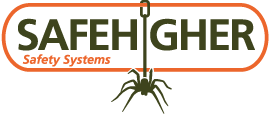Using a horizontal safety line, often referred to as a horizontal lifeline (HLL), offers several significant benefits in various industries and work environments where fall protection is crucial. Here are some of the key advantages of using a horizontal safety line:
- Fall Arrest and Fall Restraint: Horizontal safety lines are designed to prevent falls from elevated work areas. In the event of a fall, they arrest the worker’s descent, reducing the risk of severe injuries or fatalities. They can also be used for fall restraint, preventing workers from reaching the edge of a fall hazard in the first place.
- Enhanced Mobility: Unlike fixed anchor points, horizontal safety lines allow workers to move horizontally along a work area, providing greater flexibility to perform tasks across a broader space. This mobility is especially valuable when working on roofs, bridges, or other expansive surfaces.
- Continuous Protection: A horizontal safety line provides continuous protection to multiple workers simultaneously, making it an efficient choice for tasks that require collaboration among team members. This reduces the need for workers to disconnect and reconnect their fall protection equipment as they move along the work area.
- Customizable Length: Horizontal safety lines can be customized to fit the specific requirements of a job site. They can be extended or retracted as needed, ensuring that the entire work area is covered and protected.
- Increased Worker Confidence: Knowing that a horizontal safety line is in place can boost worker confidence when working at heights. This increased confidence can lead to improved productivity and better job satisfaction.
- Cost-Effective Solution: Horizontal safety lines are often a cost-effective choice compared to installing multiple fixed anchor points or other fall protection systems. They offer a versatile solution that can be adapted to different work environments.
- Compliance with Safety Regulations: Using a horizontal safety line helps organizations comply with safety regulations and standards related to fall protection, such as OSHA regulations in the United States. This reduces the risk of fines and legal liabilities.
- Versatility: Horizontal safety lines can be used in various industries, including construction, maintenance, telecommunications, and utilities. They are suitable for both temporary and permanent installations and can be set up in various configurations to meet specific job requirements.
- Minimal Maintenance: Properly maintained horizontal safety lines have a relatively low ongoing maintenance requirement, ensuring they remain operational and safe for an extended period.
- Safety Awareness: Installing a horizontal safety line promotes a culture of safety within an organization. It signals a commitment to worker well-being and emphasizes the importance of fall protection awareness and training.
In conclusion, the use of a horizontal safety line provides a versatile and effective solution for fall protection in various work environments. It enhances worker safety, mobility, and confidence while helping organizations meet safety regulations and reduce overall safety risks.
